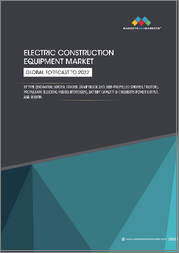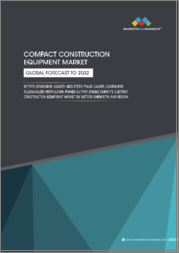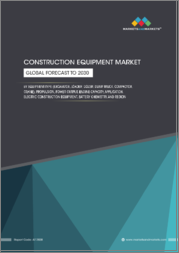
|
시장보고서
상품코드
1743793
세계의 지하 전기 인클로저 시장 : 산업 규모, 점유율, 동향, 기회, 예측 - 유형별, 용도별, 설치 유형별, 지역별, 경쟁별(2020-2030년)Underground Electric Enclosure Market - Global Industry Size, Share, Trends, Opportunity, and Forecast, Segmented By Type, By Application, By Installation Type, By Region & Competition, 2020-2030F |
||||||
세계의 지하 전기 인클로저 시장 규모는 2024년에 14억 달러로 평가되었고, 2030년에는 23억 달러에 이를 것으로 예측되며, 예측 기간 CAGR 8.6%로 성장할 전망입니다.
시장 확대의 원동력이 되고 있는 것은 스마트 그리드 인프라에 대한 투자 증가 및 배전망의 근대화입니다. 이러한 시스템에는 센서 및 제어 모듈과 같은 중요한 전기 부품을 보호하기 위해 안전하고 내후성이 있으며 조작할 수 없는 지하 케이스가 필요합니다. 신재생 에너지원, 특히 태양광과 풍력의 통합은 신뢰성 높은 에너지 흐름을 확보하기 위한 고도의 보호 시스템의 필요성을 더욱 높이고 있습니다. 아시아태평양의 신흥 시장에서 급속한 도시화 및 인프라 정비도, 특히 주택, 상업, 운수 부문에 있어 시장 성장에 기여하고 있습니다. 이와 병행하여 산업 부문에서는 자동화와 IoT 주도의 오퍼레이션으로의 시프트가 진행되고 있으며, 제어 시스템에는 신뢰성 높은 지하 보호가 요구되고 있습니다. 안전성과 지속 가능성을 중시하는 규제는 인클로저의 재료와 설계의 기술 혁신을 촉진하고 있습니다. 이러한 요인들이 맞물려 공익사업, 산업, 스마트시티 구상의 각 분야에서 지하 전기 인클로저의 왕성한 수요가 강화되고 있습니다.
| 시장 개요 | |
|---|---|
| 예측 기간 | 2026-2030년 |
| 시장 규모(2024년) | 14억 달러 |
| 시장 규모(2030년) | 23억 달러 |
| CAGR(2025-2030년) | 8.6% |
| 급성장 부문 | 유리 섬유 |
| 최대 시장 | 북미 |
시장 성장 촉진요인
스마트 그리드 도입 확대 및 도시 인프라 현대화
주요 시장 과제
높은 설치 비용 및 복잡한 유지 보수 요구 사항
주요 시장 동향
스마트하고 커넥티드한 지하 케이스의 채용
목차
제1장 개요
제2장 조사 방법
제3장 주요 요약
제4장 고객의 목소리
제5장 세계의 지하 전기 인클로저 시장 전망
- 시장 규모 및 예측
- 금액별
- 시장 점유율 및 예측
- 유형별(유리섬유, 스틸)
- 용도별(발전 및 배전, 석유 및 가스, 금속 및 광업, 기타)
- 설치 유형별(사전 설치, 필드 설치)
- 지역별(북미, 유럽, 남미, 중동 및 아프리카, 아시아태평양)
- 기업별(2024년)
- 시장 맵
제6장 북미의 지하 전기 인클로저 시장 전망
- 시장 규모 및 예측
- 시장 점유율 및 예측
- 북미 : 국가별 분석
- 미국
- 캐나다
- 멕시코
제7장 유럽의 지하 전기 인클로저 시장 전망
- 시장 규모 및 예측
- 시장 점유율 및 예측
- 유럽 : 국가별 분석
- 독일
- 프랑스
- 영국
- 이탈리아
- 스페인
제8장 아시아태평양의 지하 전기 인클로저 시장 전망
- 시장 규모 및 예측
- 시장 점유율 및 예측
- 아시아태평양 : 국가별 분석
- 중국
- 인도
- 일본
- 한국
- 호주
제9장 중동 및 아프리카 지하 전기 인클로저 시장 전망
- 시장 규모 및 예측
- 시장 점유율 및 예측
- 중동 및 아프리카 : 국가별 분석
- 사우디아라비아
- 아랍에미리트(UAE)
- 남아프리카
제10장 남미의 지하 전기 인클로저 시장 전망
- 시장 규모 및 예측
- 시장 점유율 및 예측
- 남미 : 국가별 분석
- 브라질
- 콜롬비아
- 아르헨티나
제11장 시장 역학
- 성장 촉진요인
- 과제
제12장 시장 동향 및 발전
- 합병 및 인수
- 제품 출시
- 최근 동향
제13장 기업 프로파일
- ABB Ltd.
- Eaton Corporation Plc
- Schneider Electric SE
- Siemens AG
- nVent Electric plc
- Legrand SA
- Hubbell Incorporated
- Rittal GmbH & Co. KG
제14장 전략적 제안
제15장 기업 소개 및 면책사항
AJY 25.06.18The Global Underground Electric Enclosure Market was valued at USD 1.4 billion in 2024 and is projected to reach USD 2.3 billion by 2030, growing at a CAGR of 8.6% over the forecast period. Market expansion is being fueled by increasing investments in smart grid infrastructure and modernization of power distribution networks. These systems require secure, weather-resistant, and tamper-proof underground enclosures to safeguard critical electrical components such as sensors and control modules. The integration of renewable energy sources, particularly solar and wind, has further heightened the need for advanced protective systems to ensure reliable energy flow. Rapid urbanization and infrastructure development in emerging markets across Asia-Pacific are also contributing to the market's growth, especially in residential, commercial, and transportation sectors. In parallel, the industrial sector's shift toward automation and IoT-driven operations is demanding reliable underground protection for control systems. Regulatory emphasis on safety and sustainability is driving innovation in enclosure materials and design. Collectively, these factors are reinforcing robust demand for underground electric enclosures across utilities, industries, and smart city initiatives.
| Market Overview | |
|---|---|
| Forecast Period | 2026-2030 |
| Market Size 2024 | USD 1.4 Billion |
| Market Size 2030 | USD 2.3 Billion |
| CAGR 2025-2030 | 8.6% |
| Fastest Growing Segment | Fiberglass |
| Largest Market | North America |
Key Market Drivers
Rising Deployment of Smart Grids and Urban Infrastructure Modernization
The growing implementation of smart grids and modernization of urban infrastructure are major factors propelling the underground electric enclosure market. Utilities and governments globally are investing in advanced grid systems aimed at enhancing efficiency, resilience, and sustainability. Smart grids, which integrate real-time monitoring technologies, demand reliable and tamper-proof underground enclosures for critical electrical assets. For instance, China's National Energy Administration's investment of over USD 360 billion into renewable energy underlines the importance of enclosures that protect essential components in challenging outdoor environments.
Underground electric enclosures are increasingly being used to house transformers, junction boxes, and communication equipment, offering superior protection from physical damage, environmental conditions, and unauthorized access. They are especially valuable in urban areas where above-ground installations are not feasible due to space constraints or visual impact. In emerging markets such as India, Brazil, and China, rapid infrastructure expansion in transport and housing is boosting the installation of modern underground electrical networks, fueling demand for scalable, modular enclosure solutions.
Key Market Challenges
High Installation Costs and Complex Maintenance Requirements
The underground electric enclosure market faces significant challenges due to the high cost of installation and complex maintenance procedures. Compared to overhead systems, underground installations require specialized planning, excavation, and reinforced structural measures to ensure durability under extreme environmental conditions, including moisture, ground pressure, and vehicular load.
The upfront capital costs are further elevated by the use of robust materials like stainless steel, polycarbonate composites, and fiber-reinforced plastics, which are essential to meet rigorous safety and durability standards. These costs are particularly burdensome in densely populated urban areas where installation activities can disrupt public services, resulting in additional expenses and administrative challenges.
Maintenance also presents difficulties, as accessing buried units for repairs or inspections involves surface excavation and potential rerouting of pedestrian or vehicular traffic. Unlike surface installations, underground systems require advanced detection equipment and thorough documentation, leading to longer downtimes and higher service costs during emergencies or breakdowns.
Key Market Trends
Adoption of Smart and Connected Underground Enclosures
A notable trend influencing the market is the rising adoption of smart underground enclosures integrated with IoT and remote monitoring capabilities. As utilities and industries advance toward digitization and automation, there is a growing preference for enclosures that not only protect but also actively monitor internal conditions.
These smart systems are embedded with sensors that provide real-time data on internal temperature, humidity, vibration, and potential tampering. This data supports predictive maintenance by identifying issues before they escalate, reducing repair costs and unplanned downtimes.
IoT-enabled enclosures are particularly valuable in remote or hazardous locations, where manual inspections are impractical. These systems can autonomously issue alerts or trigger predefined actions-such as shutdowns or reroutes-in response to anomalies. Cloud connectivity allows for centralized control, historical data tracking, and performance analytics, enabling more efficient asset management across smart city and industrial networks.
Key Market Players
- ABB Ltd.
- Eaton Corporation Plc
- Schneider Electric SE
- Siemens AG
- nVent Electric plc
- Legrand SA
- Hubbell Incorporated
- Rittal GmbH & Co. KG
Report Scope:
In this report, the Global Underground Electric Enclosure Market has been segmented into the following categories, in addition to the industry trends which have also been detailed below:
Underground Electric Enclosure Market, By Type:
- Fiberglass
- Steel
Underground Electric Enclosure Market, By Application:
- Power generation & distribution
- Oil & Gas
- Metals & Mining
- Others
Underground Electric Enclosure Market, By Installation Type:
- Pre-Installed
- Field-Installed
Underground Electric Enclosure Market, By Region:
- North America
- United States
- Canada
- Mexico
- Europe
- Germany
- France
- United Kingdom
- Italy
- Spain
- Asia Pacific
- China
- India
- Japan
- South Korea
- Australia
- South America
- Brazil
- Colombia
- Argentina
- Middle East & Africa
- Saudi Arabia
- UAE
- South Africa
Competitive Landscape
Company Profiles: Detailed analysis of the major companies present in the Global Underground Electric Enclosure Market.
Available Customizations:
Global Underground Electric Enclosure Market report with the given market data, TechSci Research offers customizations according to a company's specific needs. The following customization options are available for the report:
Company Information
- Detailed analysis and profiling of additional market players (up to five).
Table of Contents
1. Product Overview
- 1.1. Market Definition
- 1.2. Scope of the Market
- 1.2.1. Markets Covered
- 1.2.2. Years Considered for Study
- 1.2.3. Key Market Segmentations
2. Research Methodology
- 2.1. Objective of the Study
- 2.2. Baseline Methodology
- 2.3. Key Industry Partners
- 2.4. Major Association and Secondary Sources
- 2.5. Forecasting Methodology
- 2.6. Data Triangulation & Validation
- 2.7. Assumptions and Limitations
3. Executive Summary
- 3.1. Overview of the Market
- 3.2. Overview of Key Market Segmentations
- 3.3. Overview of Key Market Players
- 3.4. Overview of Key Regions/Countries
- 3.5. Overview of Market Drivers, Challenges, and Trends
4. Voice of Customer
5. Global Underground Electric Enclosure Market Outlook
- 5.1. Market Size & Forecast
- 5.1.1. By Value
- 5.2. Market Share & Forecast
- 5.2.1. By Type (Fiberglass, Steel)
- 5.2.2. By Application (Power generation & distribution, Oil & Gas, Metals & Mining, Others)
- 5.2.3. By Installation Type (Pre-Installed, Field-Installed)
- 5.2.4. By Region (North America, Europe, South America, Middle East & Africa, Asia Pacific)
- 5.3. By Company (2024)
- 5.4. Market Map
6. North America Underground Electric Enclosure Market Outlook
- 6.1. Market Size & Forecast
- 6.1.1. By Value
- 6.2. Market Share & Forecast
- 6.2.1. By Type
- 6.2.2. By Application
- 6.2.3. By Installation Type
- 6.2.4. By Country
- 6.3. North America: Country Analysis
- 6.3.1. United States Underground Electric Enclosure Market Outlook
- 6.3.1.1. Market Size & Forecast
- 6.3.1.1.1. By Value
- 6.3.1.2. Market Share & Forecast
- 6.3.1.2.1. By Type
- 6.3.1.2.2. By Application
- 6.3.1.2.3. By Installation Type
- 6.3.1.1. Market Size & Forecast
- 6.3.2. Canada Underground Electric Enclosure Market Outlook
- 6.3.2.1. Market Size & Forecast
- 6.3.2.1.1. By Value
- 6.3.2.2. Market Share & Forecast
- 6.3.2.2.1. By Type
- 6.3.2.2.2. By Application
- 6.3.2.2.3. By Installation Type
- 6.3.2.1. Market Size & Forecast
- 6.3.3. Mexico Underground Electric Enclosure Market Outlook
- 6.3.3.1. Market Size & Forecast
- 6.3.3.1.1. By Value
- 6.3.3.2. Market Share & Forecast
- 6.3.3.2.1. By Type
- 6.3.3.2.2. By Application
- 6.3.3.2.3. By Installation Type
- 6.3.3.1. Market Size & Forecast
- 6.3.1. United States Underground Electric Enclosure Market Outlook
7. Europe Underground Electric Enclosure Market Outlook
- 7.1. Market Size & Forecast
- 7.1.1. By Value
- 7.2. Market Share & Forecast
- 7.2.1. By Type
- 7.2.2. By Application
- 7.2.3. By Installation Type
- 7.2.4. By Country
- 7.3. Europe: Country Analysis
- 7.3.1. Germany Underground Electric Enclosure Market Outlook
- 7.3.1.1. Market Size & Forecast
- 7.3.1.1.1. By Value
- 7.3.1.2. Market Share & Forecast
- 7.3.1.2.1. By Type
- 7.3.1.2.2. By Application
- 7.3.1.2.3. By Installation Type
- 7.3.1.1. Market Size & Forecast
- 7.3.2. France Underground Electric Enclosure Market Outlook
- 7.3.2.1. Market Size & Forecast
- 7.3.2.1.1. By Value
- 7.3.2.2. Market Share & Forecast
- 7.3.2.2.1. By Type
- 7.3.2.2.2. By Application
- 7.3.2.2.3. By Installation Type
- 7.3.2.1. Market Size & Forecast
- 7.3.3. United Kingdom Underground Electric Enclosure Market Outlook
- 7.3.3.1. Market Size & Forecast
- 7.3.3.1.1. By Value
- 7.3.3.2. Market Share & Forecast
- 7.3.3.2.1. By Type
- 7.3.3.2.2. By Application
- 7.3.3.2.3. By Installation Type
- 7.3.3.1. Market Size & Forecast
- 7.3.4. Italy Underground Electric Enclosure Market Outlook
- 7.3.4.1. Market Size & Forecast
- 7.3.4.1.1. By Value
- 7.3.4.2. Market Share & Forecast
- 7.3.4.2.1. By Type
- 7.3.4.2.2. By Application
- 7.3.4.2.3. By Installation Type
- 7.3.4.1. Market Size & Forecast
- 7.3.5. Spain Underground Electric Enclosure Market Outlook
- 7.3.5.1. Market Size & Forecast
- 7.3.5.1.1. By Value
- 7.3.5.2. Market Share & Forecast
- 7.3.5.2.1. By Type
- 7.3.5.2.2. By Application
- 7.3.5.2.3. By Installation Type
- 7.3.5.1. Market Size & Forecast
- 7.3.1. Germany Underground Electric Enclosure Market Outlook
8. Asia Pacific Underground Electric Enclosure Market Outlook
- 8.1. Market Size & Forecast
- 8.1.1. By Value
- 8.2. Market Share & Forecast
- 8.2.1. By Type
- 8.2.2. By Application
- 8.2.3. By Installation Type
- 8.2.4. By Country
- 8.3. Asia Pacific: Country Analysis
- 8.3.1. China Underground Electric Enclosure Market Outlook
- 8.3.1.1. Market Size & Forecast
- 8.3.1.1.1. By Value
- 8.3.1.2. Market Share & Forecast
- 8.3.1.2.1. By Type
- 8.3.1.2.2. By Application
- 8.3.1.2.3. By Installation Type
- 8.3.1.1. Market Size & Forecast
- 8.3.2. India Underground Electric Enclosure Market Outlook
- 8.3.2.1. Market Size & Forecast
- 8.3.2.1.1. By Value
- 8.3.2.2. Market Share & Forecast
- 8.3.2.2.1. By Type
- 8.3.2.2.2. By Application
- 8.3.2.2.3. By Installation Type
- 8.3.2.1. Market Size & Forecast
- 8.3.3. Japan Underground Electric Enclosure Market Outlook
- 8.3.3.1. Market Size & Forecast
- 8.3.3.1.1. By Value
- 8.3.3.2. Market Share & Forecast
- 8.3.3.2.1. By Type
- 8.3.3.2.2. By Application
- 8.3.3.2.3. By Installation Type
- 8.3.3.1. Market Size & Forecast
- 8.3.4. South Korea Underground Electric Enclosure Market Outlook
- 8.3.4.1. Market Size & Forecast
- 8.3.4.1.1. By Value
- 8.3.4.2. Market Share & Forecast
- 8.3.4.2.1. By Type
- 8.3.4.2.2. By Application
- 8.3.4.2.3. By Installation Type
- 8.3.4.1. Market Size & Forecast
- 8.3.5. Australia Underground Electric Enclosure Market Outlook
- 8.3.5.1. Market Size & Forecast
- 8.3.5.1.1. By Value
- 8.3.5.2. Market Share & Forecast
- 8.3.5.2.1. By Type
- 8.3.5.2.2. By Application
- 8.3.5.2.3. By Installation Type
- 8.3.5.1. Market Size & Forecast
- 8.3.1. China Underground Electric Enclosure Market Outlook
9. Middle East & Africa Underground Electric Enclosure Market Outlook
- 9.1. Market Size & Forecast
- 9.1.1. By Value
- 9.2. Market Share & Forecast
- 9.2.1. By Type
- 9.2.2. By Application
- 9.2.3. By Installation Type
- 9.2.4. By Country
- 9.3. Middle East & Africa: Country Analysis
- 9.3.1. Saudi Arabia Underground Electric Enclosure Market Outlook
- 9.3.1.1. Market Size & Forecast
- 9.3.1.1.1. By Value
- 9.3.1.2. Market Share & Forecast
- 9.3.1.2.1. By Type
- 9.3.1.2.2. By Application
- 9.3.1.2.3. By Installation Type
- 9.3.1.1. Market Size & Forecast
- 9.3.2. UAE Underground Electric Enclosure Market Outlook
- 9.3.2.1. Market Size & Forecast
- 9.3.2.1.1. By Value
- 9.3.2.2. Market Share & Forecast
- 9.3.2.2.1. By Type
- 9.3.2.2.2. By Application
- 9.3.2.2.3. By Installation Type
- 9.3.2.1. Market Size & Forecast
- 9.3.3. South Africa Underground Electric Enclosure Market Outlook
- 9.3.3.1. Market Size & Forecast
- 9.3.3.1.1. By Value
- 9.3.3.2. Market Share & Forecast
- 9.3.3.2.1. By Type
- 9.3.3.2.2. By Application
- 9.3.3.2.3. By Installation Type
- 9.3.3.1. Market Size & Forecast
- 9.3.1. Saudi Arabia Underground Electric Enclosure Market Outlook
10. South America Underground Electric Enclosure Market Outlook
- 10.1. Market Size & Forecast
- 10.1.1. By Value
- 10.2. Market Share & Forecast
- 10.2.1. By Type
- 10.2.2. By Application
- 10.2.3. By Installation Type
- 10.2.4. By Country
- 10.3. South America: Country Analysis
- 10.3.1. Brazil Underground Electric Enclosure Market Outlook
- 10.3.1.1. Market Size & Forecast
- 10.3.1.1.1. By Value
- 10.3.1.2. Market Share & Forecast
- 10.3.1.2.1. By Type
- 10.3.1.2.2. By Application
- 10.3.1.2.3. By Installation Type
- 10.3.1.1. Market Size & Forecast
- 10.3.2. Colombia Underground Electric Enclosure Market Outlook
- 10.3.2.1. Market Size & Forecast
- 10.3.2.1.1. By Value
- 10.3.2.2. Market Share & Forecast
- 10.3.2.2.1. By Type
- 10.3.2.2.2. By Application
- 10.3.2.2.3. By Installation Type
- 10.3.2.1. Market Size & Forecast
- 10.3.3. Argentina Underground Electric Enclosure Market Outlook
- 10.3.3.1. Market Size & Forecast
- 10.3.3.1.1. By Value
- 10.3.3.2. Market Share & Forecast
- 10.3.3.2.1. By Type
- 10.3.3.2.2. By Application
- 10.3.3.2.3. By Installation Type
- 10.3.3.1. Market Size & Forecast
- 10.3.1. Brazil Underground Electric Enclosure Market Outlook
11. Market Dynamics
- 11.1. Drivers
- 11.2. Challenges
12. Market Trends and Developments
- 12.1. Merger & Acquisition (If Any)
- 12.2. Product Launches (If Any)
- 12.3. Recent Developments
13. Company Profiles
- 13.1. ABB Ltd.
- 13.1.1. Business Overview
- 13.1.2. Key Revenue and Financials
- 13.1.3. Recent Developments
- 13.1.4. Key Personnel
- 13.1.5. Key Product/Services Offered
- 13.2. Eaton Corporation Plc
- 13.3. Schneider Electric SE
- 13.4. Siemens AG
- 13.5. nVent Electric plc
- 13.6. Legrand SA
- 13.7. Hubbell Incorporated
- 13.8. Rittal GmbH & Co. KG
14. Strategic Recommendations
15. About Us & Disclaimer
(주말 및 공휴일 제외)


















